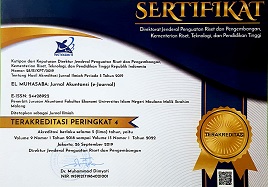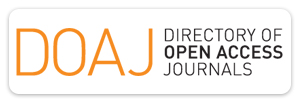ACTIVITY BASED COSTING DENGAN KENDALI WAKTU UNTUK MENGHITUNG COST LAYANAN PADA BENGKEL OTOMOTIF “DA” DI JEMBER
Abstract
One of the weaknesses of many small businesses that are encountered is the weak reporting of quantitative business activities. A common problem that occurs is about how the treatment of costs for the activities of the small and medium business units that are not in accordance with existing accounting principles. The recognition and measurenment of costs incurred in small and medium enterprises is very important to understand. It can support their entrepreneurs to make decisions, such as to determine the selling price that affects the profits to be achieved by a business. The purpose of this study uses activity based costing techniques with time drivers to calculate service costs in the "DA" automotive workshop in Jember.
The research method used is applied qualitative research. The research is directed at determining service costs by using time driver activity based costing techniques. The results of the study can be used for "DA" workshops as a comparison of service costs.
Keywords
Full Text:
PDFReferences
Anugerah, E. G., Wahyuni, N. I. and Mas’ud, I. (2017). Penerapan Target Costing dalam Pengelolaan Biaya Produksi untuk Optimalisasi Laba. e-Journal Ekonomi Bisnis dan Akuntansi, 4(1), p. 19. doi: 10.19184/ejeba.v4i1.4554.
Ayvez, E. & Pehlivanli. (2011). The Use of Time Driven Activity Based Costing and Analytic Hierarchy Process Method in The Balanced Scorecard Implementation. International Journal of Business and Management, 6(3), 146.
Badan Pusat Statistik. (2008). Berita Resmi Statistik UMKM. http://www.scribd.com/doc/16888581/ Berita-Resmi-Statistik-UMKM-Bps- 2008 html.[11 Januari 2010]
Bryon, K. et al. (2008). Time-driven activity-based costing for supporting sustainability decisions in pig production. Instituut voor Landbouw en Visserijonderzoek, Eenheid Landbouw & Maatschappij, (June 2014), pp. 1–29.
Dalci, I., Tanis, V. and Kosan, L. (2010). Customer profitability analysis with time-driven activity-based costing: A case study in a hotel. International Journal of Contemporary Hospitality Management, 22(5), pp. 609–637. doi: 10.1108/09596111011053774.
Devina, M. and Faliany, L. J. (2018). Penerapan Metode Time-Driven Activity-Based Costing Untuk Menghitung Harga Pokok Produk Jasa: Studi Kasus Salon Kecantikan Avv Make Up & Hair Do. Jurnal Akuntansi, 9(2), pp. 130–146. doi: 10.25170/jrak.v9i2.23.
Ganorkar, A. B., Lakhe, R. R. and Agrawal, K. N. (2019). TDABC for a manufacturing environment: A case study. Tékhne, 16(2), pp. 2–10. doi: 10.2478/tekhne-2019-0007.
Gunasekaran, R. Mcneil & D. Singh. (2000). Activity-Based Management In A Small Company: A Case Study. Production Planning & Control. Vol. 11, No. 4, 391 ± 399
Hicks, D. (2002). Activity-Based Costing: Making It Work for Small and Mid-Sized Companies. 2nd ed. New York: Wiley.
Hughes, A. (2005). ABC/ABM – Activity-Based Costing and Activity-Based Management: A Profitability Model For Smes Manufacturing Clothing And Textiles In The UK. Journal of Fashion Marketing And Management, 9(1), 8.
Kaplan, R. S. and Anderson., S. R. (2007). The Innovation of Time-Driven Activity-Based Costing. Journal of Cost Management, 2(2), pp. 5–15.
Kristina, Indira dan Faliany, LJade. (2018). PenerapanTime-Driven Activity Based Costing Pada Perhitungan Harga Pokok Produk Jasa Di PT Ernest Advisory. Jurnal Akuntansi, 1 (Oktober), 41 - 51
Oktavia, D. (2015). Implementasi Time Driven Activity Based Costing (Tdabc) Pada Usaha Kecil Menengah (Ukm) Tape Handayani 82 Bondowoso. Jurnal Akuntansi Universitas Jember, 11(2), p. 1. doi: 10.19184/jauj.v11i2.1262.
Pratiwi, C. H. (2018). Penerapan Akuntansi Persediaan Berbasis SAK EMKM Pada UD Andika Jaya Jember. Journal of Economic, Business and Accounting (COSTING), 2(1), pp. 118–124.
Putra, H. S. and Winarno, W. A. (2015). Perancangan Aplikasi Penentuan Harga Pokok Produksi Produk Turunan Tape Singkong Dalam Usaha Mencapai Harga Kompetitif, Jurnal Akuntansi Universitas Jember, 12(2), p. 17. doi: 10.19184/jauj.v12i2.1408.
Rahman, A. (2014). Analisa Kos Produk Dengan Menggunakan Time Driven Activity Based Costing Pada Bengkel Nasional Banyuwangi. Universitas Jember.
Supriyono. (1994). AkuntansiBiaya dan Akuntansi Pelaku usaha untuk Teknologi Maju dan Globalisasi. UPP AMP YKPN, Yogyakarta.
Szychta, A. (2010). Time-Driven Activity-Based Costing in Service Industries. Social Sciences, 1(67), pp. 49–60. Available at: https://www.researchgate.net/publication/267373766%0ATime-Driven.
Tjahjadi, B. (2010). Integrasi Time-Driven Activity-Based Costing (Tdabc) Dengan Enterprise Resources Planning (Erp): Generasi Baru Sistem Manajemen Biaya Kelas Dunia. Majalah Ekonomi Universitas Airlangga, 20(1), pp. 50–62. doi: 10.20473/jeba.V20I12010.4277.
Weygandt, J. & Kimmel, P.; Kieso, D. (2010). Managerial Accounting, Tools for Business Decision Making 5th Edition. Wiley.
DOI: https://doi.org/10.18860/em.v11i1.7710
Refbacks
- There are currently no refbacks.
Editorial Office:
Megawati Soekarnoputri Building
Accounting Department, Faculty of Economics
Jln. Gajayana 50 Telp (0341) 558881
E-mail: elmuhasaba@uin-malang.ac.id
Universitas Islam Negeri Maulana Malik Ibrahim Malang
E-ISSN 2442-8922
P-ISSN 2086-1249

This work is licensed under a CC BY SA 4.0 International License

















